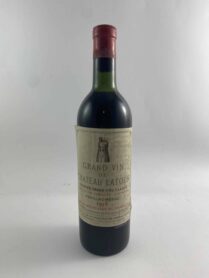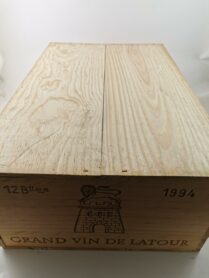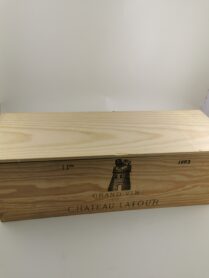Latour wine, Bordeaux wine
-

Château Latour 1958
€834.00Pauillac | Red | 0,75 L
-

Château Latour 1976
€324.00 – €418.80Pauillac | Red | 0,75 L
-

Château Latour 1994
€7 761.60Pauillac | Red | 0,75 L
-

Château Latour 1993
€5 040.00Pauillac | Red | 6 L
The origins of Latour wines, from Bordeaux
Located in the heart of the Médoc, the wines of Château Latour have a fascinating history dating back to the 14th century. Archives dating from 1331 have been found and reveal its existence through the granting of an authorization to build a fortified tower in the parish of Saint Maubert. It is in fact this tower, topped by its bell tower, which now adorns the label of the bottles.
The history of Latour is marked by its heritage stability. After a series of marriages and inheritances, the estate remained in the Ségur family for nearly 300 years. First, through Alexandre de Ségur, who acquired the Lafite estate in 1716, then through his son Nicolas-Alexandre, nicknamed “the Prince of Vines”, who enlarged his lands with the acquisition of Mouton and Calon.
During the eighteenth century, Latour wines attracted attention across the Channel. Enjoying a growing reputation, this one is classified Premier Grand Cru in 1855, in a group that also includes Margaux, Lafite-Rothschild, Haut-Brion and Mouton Rothschild since 1973.
In 1962, the Latour estate, until then still in the hands of the heirs of the Ségur family, was bought by two large British groups, Pearson and Allied Lyons. At the head of the Château, Allied Lyons understands that the management of the estate is costly, the market is down and the vintage is going through a troubled period. Defects of sharpness will affect several vintages.
The sale of the Premier Grand Cru has been completed. In 1993, François Pinault took over the reins via his holding company Artémis and gave new life to Château Latour. Always in search of an extreme precision in the elaboration of the wines, the systems of wine making, the cellars, the vat room are modernized.
In 1998, Frédéric Engerer was appointed manager with a new technical team, aiming to improve the quality of Château Latour wines. The commercial strategy changes, the first wine is rarefied, the Château develops the Forts de Latour and the Pauillac de Latour.
Out of respect for the environment, Château Latour turned to biodynamic farming in 2009. The first trials are conclusive on the twenty or so hectares tested. Thus, in 2015 the entire estate, i.e. 92 hectares, was launched towards organic certification, which it will obtain in full in 2018. Château Latour will be the first of the Premier Grands Crus to produce organically.
The terroir of Latour
The vineyards of Château Latour benefit from an ideal location and the terroir of Pauillac. Of the 92 hectares of the estate, 47 hectares of vines are dedicated to the Grand Vin de Latour and are located on a single gravelly hillock called “L’Enclos” between the châteaux Pichon-Longueville Lalande and Léoville Las Cases. Close to the Gironde, this hillock has a well-drained clay subsoil that gives the wine elegance and great concentration.
The estate has several plots replanted between 1963 and 1968 where the vines are the basis for the production of Les Forts de Latour wine.
The grape variety remains faithful to its terroir with a majority of Cabernet Sauvignon (76%) giving this character, this color, this freshness which characterize the wines of Château Latour. 22% of Merlot, then 2% of Cabernet Franc and Petit Verdot are also present.
Vinification of Latour wines, from Bordeaux
To preserve the quality of the grapes, the harvest is done exclusively by hand. The grapes are meticulously picked in order to harvest only ripe grapes. The grapes are de-stemmed, crushed and then put into stainless steel fermentation vats. It is sorted according to the age of the vines, the grape variety and the historical context. It is essential to build up harmonious sets from the harvest onwards.
During the run-off, the wine is separated from its marc and then kept again in vats in order to proceed with the malolactic fermentation. This step is crucial and determines the suppleness, the precision and the roundness of the wine.
Following this stage, the tasting of the vats, the blending and the maturing begin. Latour wines are aged entirely in oak barrels for 18 months. 5 to 6 times, the wines are racked to dissociate the clear wine from its lees. The tasting will determine the date of bottling.
Each year, the property produces about 400,000 bottles. The most prestigious, the Grand Vin de Latour has about 220,000 bottles, 140,000 for the Forts de Latour and the rest in Pauillac.
The wines of Château Latour
Since 2012, Château Latour no longer sells its wines en primeur but only “deliverable” when the wine has reached maturity. The wines are therefore ready to be drunk or they can be kept for a few years in the cellar. This is a singularity of Château Latour among the First Great Classified Growths.
The Grand Vin de Latour is made up of the old vines and the most beautiful parcels of the estate. Present at 90% in the blend, Cabernet Sauvignon is the ultra dominant grape variety. It is aged entirely in new barrels. The greatest vintages allow this wine to go through decades and to have an exceptional ageing potential.
Les Forts Latour is a second wine no less worked than the first. The quality of this wine can place it at the level of the Grands Crus of the Médoc. Its maturation varies, the percentage of new barrels is proportioned according to the structure of the wine (50 to 60%). Although the blend may differ from year to year, Merlot takes a more important place (25%) than in the Grand Vin.
The Pauillac produced since 1989 is made from the youngest vines of the Château and from less prestigious terroirs. 20% new barrels is introduced, with a blend around 45% Merlot.
The ideal storage temperature is between 10 and 13°.
Aromas and vintages of Latour
This Premier Grand Cru Classé is generally dense. After several years of ageing, it reveals a great aromatic intensity. We find aromas of cherry pits, notes of cedar, tobacco and licorice.
On the nose, it opens with fruity aromas. It is a dense, tannic, compact wine with a beautiful aromatic structure that can be explained by the terroir, of which the Cabernet Sauvignon grape is the key element.
This wine will go perfectly with tournedos rossini style, a suckling lamb, a beautiful entrecote accompanied by ceps of Bordeaux.
The best vintages for this great wine were 1929, 1945, 1961, 1982, 1990, 2005, 2009, 2010. It got that famous 100/100 rating by Robert Parker on the 1961, 1982, 2003, 2009 and 2010 vintages.
